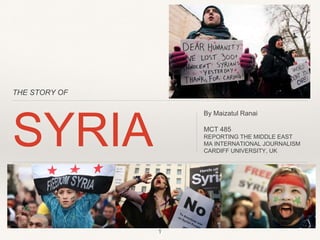Syria presentation mr pp
- 1. THE STORY OF SYRIA By Maizatul Ranai MCT 485 REPORTING THE MIDDLE EAST MA INTERNATIONAL JOURNALISM CARDIFF UNIVERSITY, UK 1
- 2. SYRIA â Population : 22,087,048 â 5,000 people flee Syria everyday (UN, 2014) â Language Spoken : Arabic, Kurdish, Armenian, and Turkish. â Religion : Islam, Christianity, Druze and Judaism
- 3. WHEN SYRIA MAKES HEADLINES? â In March 2007, Arab Spring protest were raging across the middle east. â The protest inspired the people to rise up against the President Basyar Al-Assad. 1. Commander-in-chief of Syrian Armed Forces 2. Second son of second son of former Syrian President Hafez al-Assad 3. Born on Sept 11, 1965 4. Fluent in English and French 5. Graduated from University of Damascus in Medicine 6. Aims to reform the corruption in the government, and spoke of moving Syria toward the computer technology, internet and cell phones of the 21st century.
- 4. Baath Rule AL-ASSAD FAMILY 1. Part of Military Junta that seizes power in Syria in March 1963. 2. Became Syrian President from 1970 - 2000 3. Died on June 10, 2000 at the age of 69. Hafez al-Assad Basyar al-Assad
- 5. AL-ASSAD REGIME 1. The Assadâs family has ruled Syria for five decades through MILITARY DICTATORSHIP NO POLITICAL FREEDOM NO FREEDOM OF SPEECH NO FREEDOM OF CONSCIENCE 1. A State-run system 2. Income Inequality 3. High Unemployment ECONOMIC PAIN
- 6. SYRIAN FLAME, 2011 1. The spark that lit the flame in Syrian began in 2011, when 15 school kids in the southern Syria city of Daraa painted anti- government graffiti on the walls of a school. The kids were arrested and harshly punished. 2. The community was outrage over the childrenâs arrest and mistreatment, of which it has helped spread the Syrian opposition. More at : 1. http://edition.cnn.com/2012/03/01/world/meast/syria-crisis-beginnings/ 2. http://content.time.com/time/world/article/0,8599,2060788,00.html
- 7. SYRIAN FLAME, 2012 â The uprising around the country has sparked and lasted for months. â The regime controlled the protest by force, gunfire and shelling. â The protestors reacted by organising a rebel army of loose group of fighting brigades.
- 8. Residents protest against Syriaâs President Bashar al-Assad after a burial ceremony for what activists say are victims of shelling by the Syrian army, in the Khalidiya neighborhood in Homs, on February 4, 2012. Syrian forces killed more than 200 people in an assault on the city of Homs, activists said, the bloodiest day of an 11-month uprising against Assad. (Reuters) SYRIAN FLAME, 2012
- 9. SYRIAN CIVIL WAR â 1. In July 2012, the Red Cross officially call it the Civil War (also known as Syrian Revolution).2.The Syrian regime is accused of torturing prisoners and targeting civilians in deadly rage. 3. AL QAEDA STEPS IN.
- 10. UN PRESSURE FRANCE UNITED STATES BRITAIN TURKEY CHINA RUSSIA IRAN Death Toll in Syria : 220,000 people 15 March 2011 â 15 January 2015 Source : United Nation
- 11. ISIS IN SYRIA â Starts as Al-Qaeda-inspired Sunni Islamist Brigade. â ISIS split from Al-Qaeda in February 2014, as the latter claimed that ISIS was too brutal for Al- Qaeda. â The organisation folded the Baathist regime into their sunni structure, of which Baathist eventually forms the core of ISIS. (Khan, Veryan (2014). Terrorism Research & Analysis Consortium. â The chaos in Syria allowed ISIS to hold its territory pretty securely (weaponry & money). . â A study by the London-based Conflict Armanent Research consultancy found that IS militants had access to large numbers of US weapons. No conclusions are retrieved on how the weapon are sourced.
- 12. HOPE FOR SYRIANS â The war is about to enter its 5th year, with no end at sight. â Despite the unraveling of their state and violence, most Syrians still want their tattered nation to remain whole.
- 13. THE END THANK YOU FOR LISTENING ____________________________________________













